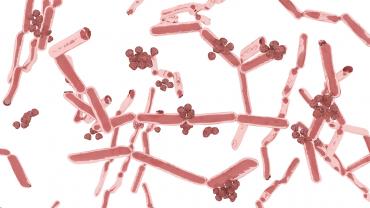
The topic of aging has become exceedingly popular both in mainstream and nutritional science. Even the United Nations has proclaimed 2021 to 2030 to be “the decade of healthy aging.” Aging is a natural process that typically accompanies biochemical and physiological changes that disrupt normal cellular function. Two primary factors shown to contribute to cellular dysfunction during aging include chronic low-grade inflammation (a phenomenon coined “inflammaging”) and intestinal dysbiosis, or an imbalance in gut microbial composition.
Although mutual causality has not been fully determined, continuous, low-grade inflammation and gut dysbiosis are strongly intertwined as evidenced by studies that demonstrate a well-balanced gut promotes a healthy inflammatory response and reduces pro-inflammatory activity, particularly in the aging microbiome. One may trigger the other and vice versa. As cellular structure and function decline during aging, these can contribute to a variety of chronic conditions such as cardiovascular disease, intestinal permeability, increased susceptibility to infection, disorders of the gastrointestinal tract, nutrient malabsorption, impaired immune function, cognitive decline, sarcopenia, and gut dysbiosis. These conditions often give rise to more inflammation in the body.
In a recent review published in Nutrients, Warman and colleagues examined the potential role that probiotics and two types of prebiotics (resistant starch and resistant proteins) play in supporting health in aging populations, specifically how they impact inflammation. It is well-known that prebiotics and probiotics promote gut health, but until recently there was not much research showing their potential effects on inflammatory activity in older adults.
The researchers highlight several strains and species of Lactobacillus spp. and Bifidobacterium that possess anti-inflammatory activity and demonstrate gut and immune benefits in aging populations. In elderly humans and aged animals, supplementation with SCFA-producing bacterial strains attenuated age-related loss of mucin and imparted other health and immune benefits. Akkermansia muciniphila and Faecalibacterium praunitzii are butyrate-producing bacteria that were shown to activate colonic mucus production and reduce colonic expression of proinflammatory genes and pathways in accelerated aging animal models. Maintaining a thick layer of mucus acts as a barrier against potential pathogenic bacteria that promotes pro-inflammatory mediator production and activity.
Resistant starches are unable to absorb liquid or do not fit into the enzymatic binding site of amylase, so they resist the action of amylase in the small intestine. The undigested starch progresses to the large intestine where it is fermented by resident microorganisms, producing metabolites such as short-chain fatty acids (SCFAs) that provide numerous health benefits.
Two of the most sought-after health benefits of resistant starches are optimization of commensal microbes and glycemic control. These benefits provide secondary health effects for patients, such as weight management, improved metabolic markers, modulation of inflammation, and oxidative stress, which can support healthy aging. Bacterial fermentation of resistant starches produces gases, SCFAs (acetate, propionate, butyrate, and valerate), and lesser amounts of organic acids, branched SCFAs, and alcohols. Many of these byproducts lower the pH of the large intestine, which positively influences the classes of bacteria that survive and grow, in addition to the gene expression of both bacteria and colonic cells. Butyrate is the preferred energy source for human colonocytes and plays a vital role in maintaining microbial balance and suppressing inflammation by modulating the immune system. Prebiotic intervention in the form of resistant starches ensures a more effective optimization of gastrointestinal health and the microbiome than probiotics alone.
Resistant proteins, on the other hand, are less well-known, but they possess comparable properties to resistant starches and are derived from proteins that are resistant to human proteases. Resistant proteins are found naturally in soybeans, buckwheat, rice, potato, sericin, and eggshell membrane and have low digestibility. Resistant proteins are also fermented by gut bacteria and have been shown to restore populations of SCFA-producing bacteria, contribute to overall microbial diversity, and reduce dysbiosis, which are all factors to support healthy aging.
Practitioners are becoming familiar with the use of prebiotics to enhance the effects of probiotics and optimize the microbiome. In addition to supplemental prebiotics, dietary resistant starches and resistant proteins, which are another form of prebiotic, fermentable fiber, confer similar benefits as other prebiotics, but these may augment the benefit because they can be incorporated into daily meals. Although more research is needed to fully understand the significance of probiotics, resistant starches, and resistant proteins in supporting a normal inflammatory response during aging, the current evidence suggests that collectively they have the potential to promote healthy aging.
By Caitlin Higgins, MS, CNS